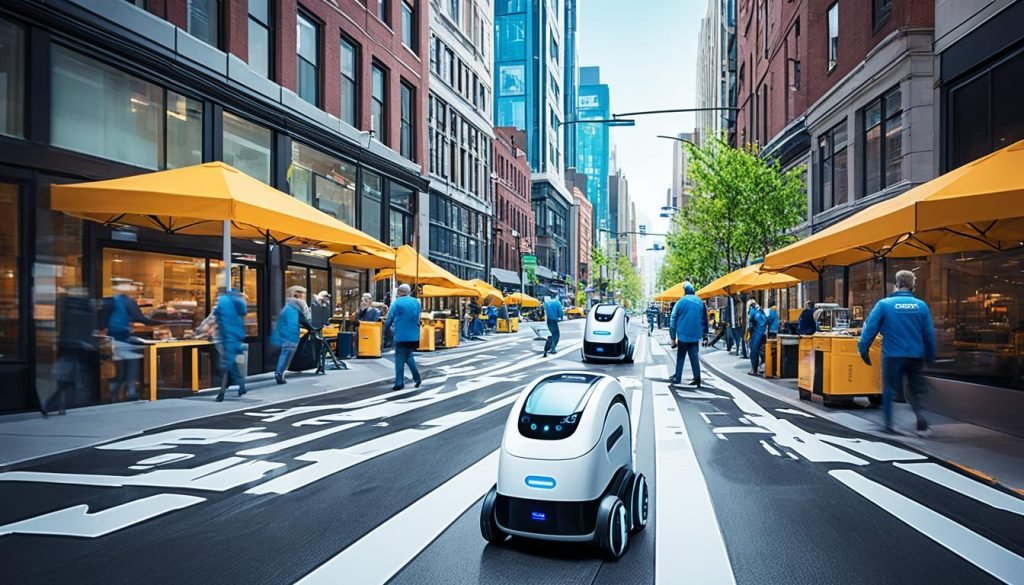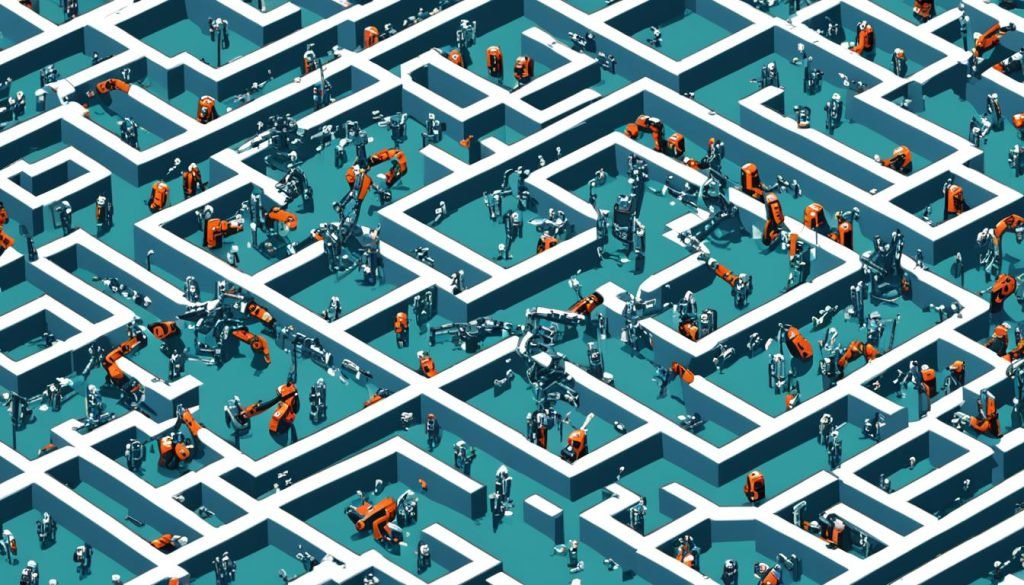The future of robotics is looking bright as we head towards 2030. Technology is becoming a bigger part of our lives and various industries. We’ll see big steps forward in robotic automation thanks to artificial intelligence (AI) and machine learning.
The robotics industry is growing fast and moving beyond just making things. It will start to help with household tasks and healthcare. Robots will take on harder tasks, making them useful in more areas. This will lead to talks about how we work with robots and the right way to use them.
This change will change how we work and improve our lives. It will help solve problems like not having enough workers and help the environment. Robots will have a big impact on society, making things better for everyone.
Key Takeaways
- The future of robotics is driven by advancements in artificial intelligence and machine learning.
- Robots are expected to integrate more into everyday life, enhancing convenience and efficiency.
- There will be a continuous evolution in the types of tasks that robots can perform.
- Ethical considerations will play a crucial role in the development and use of robotics.
- Robotics will significantly influence industries like healthcare, agriculture, and manufacturing.
Technological Advancements Shaping Robotics
Robots are getting smarter thanks to ongoing innovations. Artificial intelligence is key in this change, making robots more adaptable. We’re seeing big steps forward in AI, machine learning, and natural language processing. These areas are changing robotics for the better.
Integration of AI and Machine Learning
Artificial intelligence and machine learning are changing how robots work. Better algorithms let robots learn from their actions and get better at their jobs. This leads to big improvements in areas like healthcare and cars.
Deep Learning and Neural Networks
Deep learning uses neural networks for complex decisions. Robots get better at tasks like recognizing images and finding their way on their own. These updates mean robots work smarter and can understand their world better, fitting with the latest trends in robotics.
Natural Language Processing Enhancements
Natural language processing is a big deal for robots. It lets them understand and respond to human speech better. This is key for things like customer service and helping people at home, showing how robots are getting better at working with us.
| Technology | Description | Impact on Robotics |
|---|---|---|
| Artificial Intelligence | Enables machines to simulate human intelligence and decision-making. | Increases adaptability and efficiency in robotics tasks. |
| Machine Learning | Allows robots to learn from data and improve performance over time. | Enhances robotic functions in diverse environments. |
| Deep Learning | Utilizes neural networks to process complex inputs. | Improves recognition and navigation capabilities. |
| Natural Language Processing | Facilitates communication between humans and machines. | Enhances user interaction and emotional responsiveness. |
Future of Robotics: Key Trends to Watch
The world of robotics is changing fast, moving toward a future filled with automation. Two big trends will shape this change: the growth of autonomous technologies and a focus on customization in robotics. These trends will change how we interact with technology, make things more efficient, and give us experiences that fit our needs.
Rise of Autonomous Technologies
The increase in autonomous robots is a big deal for society. These robots, from smart home gadgets to industrial ones, can do complex tasks on their own. Thanks to new tech, they use sensors and AI to move around, make choices, and talk to humans easily.
This tech is changing many areas like logistics, healthcare, and manufacturing. It makes things more efficient and precise. We’re seeing more future applications of robotics in these fields.
Customization and Personalization in Robotics
Robots are becoming a big part of our lives, and making them fit what we need is key. Being able to change robots for our own use makes a big difference. We’re seeing robots that can change how they work based on what we want.
This means we’ll see robots that help with health care in new ways and learning tools that fit how each student learns. It will make people happier with their robots and open up new uses for them in different areas.
| Trend | Description | Impact |
|---|---|---|
| Autonomous Technologies | Development of self-operating robots with advanced AI. | Enhances efficiency in industries such as logistics and healthcare. |
| Customization | Robots designed to meet individual user needs. | Improves user experience and expands market applications. |
Impact of Robotics on Various Industries
Robotics is changing many areas like healthcare, manufacturing, and agriculture. These changes come from new technologies that make things more efficient and precise.
Robotics in Healthcare
Healthcare is seeing big changes thanks to robotics. Robots help with surgeries, making them less invasive and more precise. They also help with patient care, especially in places far from doctors.
This makes healthcare better and helps more people get the care they need.
Transformations in Manufacturing
Manufacturing is also being changed by robotics. Now, we see smart factories where robots make things more efficient and reduce waste. This means production can grow and companies can meet demand better.
Adding AI to these robots makes them even better at adapting to different needs.
Robotics in Agriculture and Beyond
Agriculture is also seeing big changes with robotics. Robots like tractors and drones help with farming, making it more precise. This helps farmers use less resources and get more food.
This is good for farmers and helps make sure we have enough food. It shows how robotics can help many different areas.

Challenges Facing Robotics Development in the Future
The growth of robotics is bringing new chances, but it also has big challenges. We must tackle these challenges to make sure technology helps everyone. Ethical issues in AI and the fear of losing jobs to robots are top concerns.
Ethical Considerations in AI and Automation
As robots use more AI, we face big ethical questions. Privacy, data safety, and who’s to blame need to be talked about more. It’s key that AI is clear and fair to gain trust and acceptance.
Addressing Potential Job Displacement
Automation makes things more efficient but worries about losing jobs grow. Many jobs could be taken over by robots. This means we need to focus on training and updating skills for the new job world.

| Challenges | Implications | Potential Solutions |
|---|---|---|
| Ethical Considerations in AI | Privacy issues, bias, lack of transparency | Establish ethical guidelines and regulatory frameworks |
| Job Displacement due to Automation | Loss of traditional jobs, workforce disruption | Implement retraining programs and develop new job opportunities |
| Adapting to Rapid Technological Change | Difficulty in keeping up with advancements | Encourage continuous learning and innovation |
Conclusion
The future of robotics is bright, thanks to ongoing tech improvements. Robots are getting smarter with AI, deep learning, and natural language processing. They can now handle simple and complex tasks across many industries.
This leads to more efficiency and changes how businesses work. It shows the big changes in using robots in different areas.
But, we must watch out for the challenges these robots bring. Issues like ethics and job loss are big concerns. It’s important to manage these risks well.
By 2030, knowing about robotics will be crucial for everyone. Being ready for these changes will help us enjoy the benefits of robots. These tech advances are changing our lives for the better.


